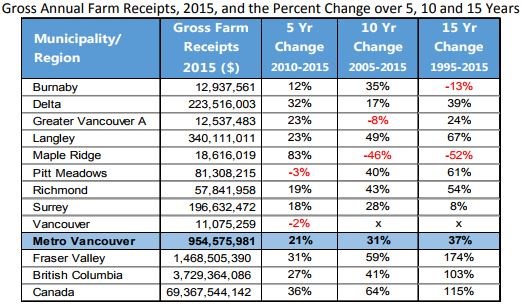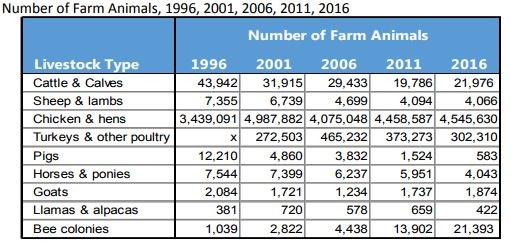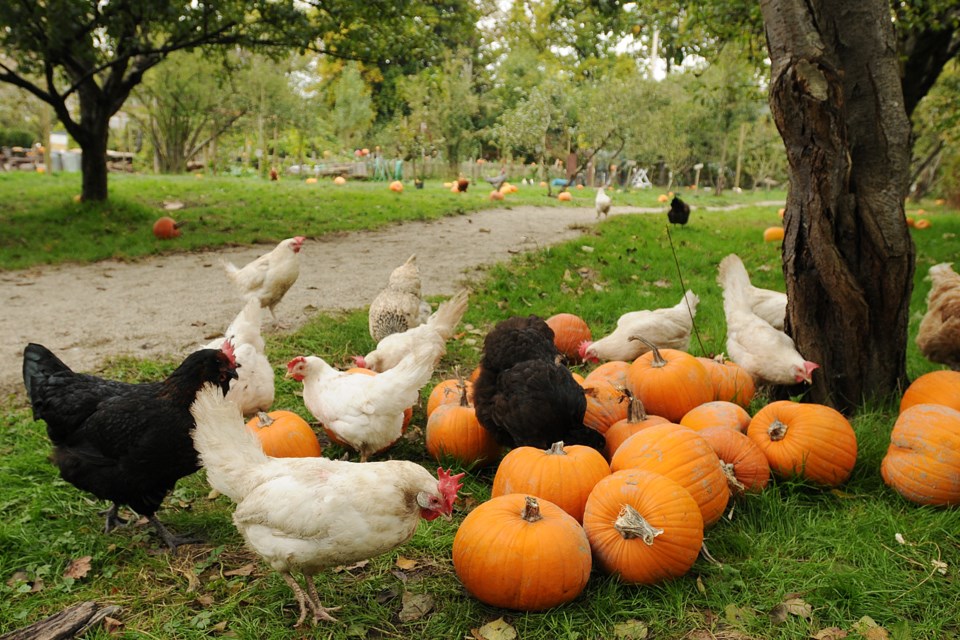Let me begin by saying Iâm kind of hungry.
Thatâs what happens after you read a report about the number of farms in Metro Â鶹´«Ã½Ó³»that continue to produce a ton of food for all of us to consume.
Take a guess how many farms we have here in Vancouver.
As you might imagine, itâs not a lot.
But the 40 farms that do exist in Â鶹´«Ã½Ó³»make a considerable amount of cash, according to a report that went before the Metro Â鶹´«Ã½Ó³»regional planning committee Sept. 8. In a category called âgross farm receipts,â Vancouverâs 40 farms produced $11,075,259 in 2015.
Those figures were collected for the 2016 Census of Agriculture, a data exercise that requires all agricultural operations in Canada to complete. Farm operators, of which there are 50 in Vancouver, provide us farm fans with a tractor load of fascinating information.
And when I say fascinating, I mean knowing what types of crops are the most popular on Metro farms and how many farm animals are living on those farms. Although the data does not identify specific farms that have the most crops or livestock, a whopping 4,545,630 chickens and hens were recorded across the region.
The Metro Â鶹´«Ã½Ó³»area, by the way, stretches from Bowen Island to Langley, where there are 1,103 farms, the most in the region. Surrey is second at 439, followed by Maple Ridge (203), Richmond (189) and Delta (185).
The grand total of farms in the region is 2,412 and they produced $954,575,981 in 2015. About 49 per cent of the farms are less than four hectares in size, with the average size of a Â鶹´«Ã½Ó³»farm at 3.9 hectares.

Back to the livestockâ¦
Second to chickens were turkeys and âother poultry,â totalling 302,310. Other livestock included cattle and calves (21,976), horses and ponies (4,043), sheeps and lambs (4,066), goats (1,874), alpacas and llamas (422) and pigs, which totalled 12,210 in 1996 but dropped significantly to 583 in 2015.
Bee colonies saw the biggest percentage growth of âfarm animalsâ since 1996, when 1,039 were recorded. There are now 21,393 colonies in Metro Vancouver, suggesting farmers are more interested in producing honey than they are in raising porkchops.

As for crops, blueberries are the runaway winner, with 5,175 hectares devoted to growing one of my favourite fruits. Cranberries are grown over 2,267 hectares, although the report noted the data was incomplete because of âconfidentiality reasonsâ in some municipalities.
Raspberries are the third most popular planted crop, spread over 134 hectares. Then comes âother fruit and nutsâ (115), grapes (98), fruit trees (83) and strawberries (74). Are you hungry yet? Inspired to head out to your nearby farmersâ market this weekend?
Sadly, all this deliciousness has a sour aftertaste.
Metro Â鶹´«Ã½Ó³»has seen a steady decline in the number of farms at both the regional and municipal level â a 14 per cent decline in the past five years; only Burnaby showed an increase at nine per cent.
Also, the total farm area in the region (38,380 hectares, or 94,799 acres) is at its lowest in 20 years.
Why is this happening?
The data shows farm operators in the 35 to 54 age group are getting out of the business, with 425 fewer farmers working than five years ago. That same time period saw 138 fewer farms producing hay and field crops and 73 fewer nursery and sod farms.
And thereâs this:Â The average farm operating expenses increased by 18 per cent in the region.
Itâs not good news as the region prepares to make room for the one million people predicted to move into Metro by 2040. Iâm guessing not many of those folks will be farmers. And with developable land becoming scarce â and at a premium â the pressures to develop on agricultural land are real.
Various documents Iâve read suggest the Metro Â鶹´«Ã½Ó³»agency and the Agricultural Land Commission are committed to keeping farm land for farming. That is evident in the recent memorandum of understanding signed by both agencies.
The document identifies their shared interests, which includes maintaining âstrong linkages with the farming community to ensure that policies, actions and emerging issues are recognized and addressed in [a timely manner] to protect agricultural land and farming viability over the long term.â
Viability, thatâs an interesting word.
Which makes me wonder: As farms continue to decrease in the region, will there come a day when we see politicians shift gears from talking about the need for so-called affordable housing to initiate an aggressive campaign to build affordable farms for the public good?
Iâm getting hungry thinking about it.
@Howellings



